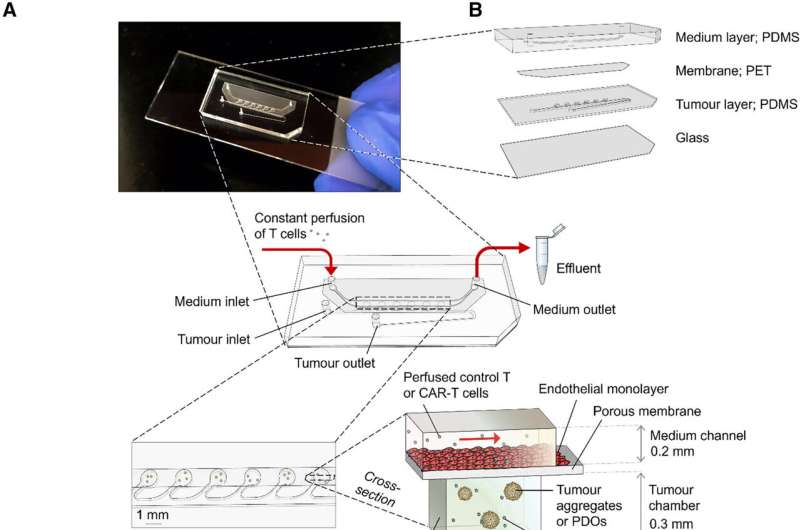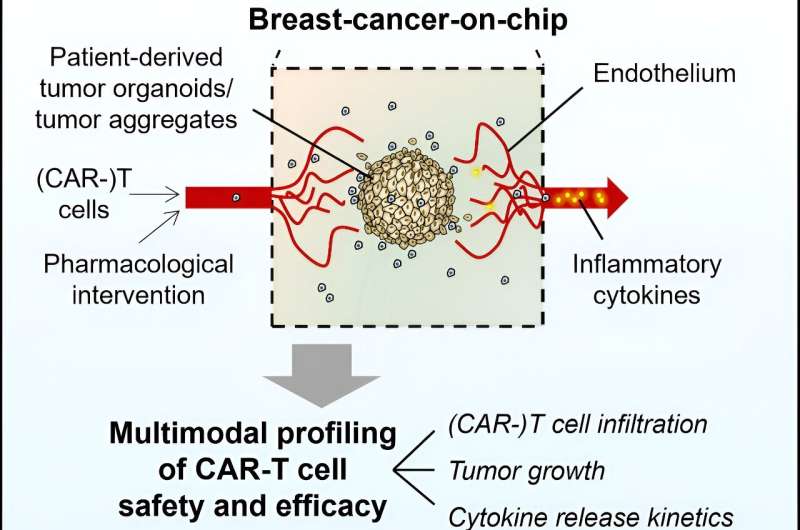This article has been reviewed according to Science X's editorial process and policies. Editors have highlighted the following attributes while ensuring the content's credibility:
fact-checked
peer-reviewed publication
proofread
Tumor tissue on a chip: New possibilities for cell therapies and personalized medicine

How do tumors react to a certain therapeutic approach? Knowing this before the start of a therapy would be of enormous value for people suffering from cancer as well as for the doctors treating them.
Researchers at the NMI Natural and Medical Sciences Institute in Reutlingen and the University Hospitals of Tübingen and Würzburg have now made this very observation possible for the promising CAR-T cell therapy—in real time and on the tissues of patients.
"This allows us to individually investigate how exactly these tumor cells react to the planned therapy, what side effects may be expected and how these can be reduced," explains Peter Loskill, professor at the University of Tübingen and group leader at the NMI. The researchers have now published their development in the journal Cell Stem Cell.
This observation was made using tumor-on-chip technology: In this case a complex in vitro system of a breast cancer tumor based on human cells, in which tumor tissue was cultivated outside the body. The researchers not only recreated the complex 3D microenvironment of a tumor, but also enabled blood vessel-like perfusion, i.e. the flow of an artificial blood substitute through the chip. The CAR-T cells were also supplied to the tumor cells via this blood substitute and their effect directly observed.
Cancerous tissue often has the ability to deceive the human immune system—which is precisely what makes it so dangerous. In the human body, so-called T cells, a special type of white blood cell, are responsible for recognizing and destroying foreign structures. However, many tumors send out signals that inhibit their activity and function.

For CAR-T cell therapy, the T cells are isolated from the blood of the diseased person and then genetically modified in the laboratory ("in vitro"). This gives them the ability to specifically recognize the dangerous cancer cells and also to remain in the body for a long time to fight cancer. The therapy has enormous potential in the fight against cancer.
When the modified T cells come into contact with the cancerous tissue, they release various cytokines. Cytokines are messenger substances that the cells release, for example to recruit other cells to the site.
Sometimes, however, this cytokine release can be very strong. This is called cytokine release syndrome (CRS). This process leads to inflammation throughout the body and manifests itself in symptoms such as fever, chills or nausea, but can also lead to organ failure and other life-threatening symptoms.
"The tumor-on-chip technology gives us the opportunity to observe cells that originate from the specific tumor we want to fight," explains scientist Tengku-Ibrahim Maulana from the Faculty of Medicine at the University of Tübingen.
"This means we can see how the patient's tumor reacts to CAR-T cell therapy and also how drugs work in the event of a cytokine storm."
Organ-on-chip technology, such as the tumor-on-chip model developed here, makes it possible to simulate complex human biological processes outside the human body and even to record patient-specific differences. This opens up completely new possibilities, especially for novel therapeutic approaches such as cell, antibody and gene therapies, which in future will make it possible to make human-relevant, patient-specific statements even before clinical trials. This could open up a new perspective for patients. However, further research is needed.
More information: Tengku Ibrahim Maulana et al, Breast cancer-on-chip for patient-specific efficacy and safety testing of CAR-T cells, Cell Stem Cell (2024). DOI: 10.1016/j.stem.2024.04.018



















